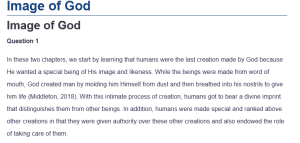Image of God
Question 1
In these two chapters, we start by learning that humans were the last creation made by God because He wanted a special being of His image and likeness. While the beings were made from word of mouth, God created man by molding him Himself from dust and then breathed into his nostrils to give him life (Middleton, 2018). With this intimate process of creation, humans got to bear a divine imprint that distinguishes them from other beings. In addition, humans were made special and ranked above other creations in that they were given authority over these other creations and also endowed the role of taking care of them.
I believe that the author included two creation accounts meant to showcase God and His divine authority and His personal relationship with human beings. The first account, as told in Genesis 1, is about God’s sovereign power in the creation of the universe, taking into account the magnificent process of it all, from the creation of the sun and moon to the smallest of animals and plants (Middleton, 2018). Contrastingly, the second account in Genesis 2 is about the intimate creation of a more personal being to God, highlighting the difference in the relationship between God and other creations and between God and human beings.
Question 2
There are a few lessons we learn about sin from Genesis 3. The first is that sin comes about when we doubt God and His goodness, ignore His commands, and then convince ourselves to go against His commands. In verse 7, we learn that sin always results in shame and destroys the relationship God created between Him and us at the beginning. For example, the consequence of Adam and Eve’s sin was being exiled from the Garden of Eden, which created a physical and spiritual rift between them and God (Tompkins, 2013). This chapter also highlights how sin results in the suffering of human beings, including pain and death.
In addition, in verses 9, 11, and 13, we also learn that God responds to sins through the invitation of a confession (Holy Bible, 2008). He also responds by promising to get rid of evil, i.e., the serpent, in verse 15. Here, we learn that even though sin destroys our relationship with God, He has offered a way to mend this relationship and eliminate the evil.
Question 3
In Genesis 2:15, the account states, “The Lord God took the man and put him in the Garden of Eden to work it and take care of it” (Holy Bible, 2008). Here, humans are instructed to engage in work that helps the earth flourish, both the land and animals. Seeing as humans depended on plants and meat to survive, this command also implies that they were tasked with the job of preservation and maintaining sustainability. Secondly, in Genesis 1, Adam and Eve are commanded to multiply and fill the earth, meaning they were given the duty of ensuring that God’s creation does not go extinct and continues to grow.
Question 4
Having the likeness of God signifies that, unlike all other creations, human beings possess inherent value and worth, making their life sacred (Robert, 2009). That is why taking the life of another human being is deemed wrong, and a lot of effort is also put into trying to preserve said life. In addition, it also means that God’s character is a part of human beings, which consists of morality, goodness, and love, among other characteristics of the most High.
In addition, being in God’s image also means that humans have a spiritual component in them. The Bible in Thessalonians 5:23 “This word strongly indicates that man is of three parts; spirit, soul and body. The spirit as our inmost part is the inner organ, possessing God-consciousness, that we may contact God” (Holy Bible, 2008). This signifies that humans were also given a special connection with God that no other creature was, which is why only humans worship and pray to God.
References
Holy Bible (NIV). (2008). United States: Zondervan.
Middleton, J. R. (2018). What is the relationship between the creation accounts in Genesis 1 and 2. Biologos. https://biologos.org/articles/what-is-the-relationship-between-the-creation-accounts-in-genesis-1-and-2.
Robert, W. (2009). Human, life, and other sacred stuff. Journal for Religious and Cultural Theory 10.1 64-80. http://works.bepress.com/william_robert/6
Tompkins, A. (2013). Dynamics of Shame in Genesis 3 and 4: Missiological Implications for Today. Journal of Adventist Mission Studies, 9(1), 14 20. https://dx.doi.org/10.32597/jams/vol9/iss1/3/
ORDER A PLAGIARISM-FREE PAPER HERE
We’ll write everything from scratch
Question
Getting Started
In the film, The Sound of Music, Maria sang, “Let’s start at the very beginning, a very fine place to start.” In a similar way, we are going to start with the first book of the Bible to engage in Biblical study.
In this discussion, you will take some time to study the Bible. One of the ways to people do this is called Inductive Bible Study. The inductive method of Bible study is a systematic approach to studying the Bible that involves three steps: observation, interpretation, and application.
- Observation involves reading the passage carefully and asking questions about what you see. What is the main point of the passage? What are the key details? What is the context of the passage?
- Interpretation involves trying to understand what the passage means. What is the author trying to say? What is the meaning of the passage for its original audience? What is the meaning of the passage for us today?
- Application involves asking how the passage can be applied to your life. What does the passage teach you about God? What does the passage teach you about yourself? What does the passage teach you about how to live?
The inductive method of Bible study is a helpful way to gain a deeper understanding of the Bible. It allows you to ask questions, think critically, and apply the Bible to your life.
If this sounds a lot like SOAP, you are right!
Upon successful completion of this discussion, you will be able to:
- Identify human behavior as expressed in biblical literature.
- Summarize ways in which humans are created in the image of God.
Background Information
The historical books of the Bible tell the story of how God created the world and everything in it, how He chose a people for Himself, and how He led them through many different challenges and trials. These books also record the lives of many great men and women of faith, such as Abraham, Moses, David, and Jesus.
The historical genre of the Bible is important because it provides us with a foundation for our faith. It shows us that God is real and involved in the affairs of human history. It also shows us that God is faithful to His promises and will always be with His people. This genre of the Bible also teaches us about the character of God. We see that God is loving, merciful, and just. We also see that God is also a God of justice. These biblical books are a rich and valuable resource for Christians. They provide us with a foundation for our faith, teach us about the character of God, and show us how God has worked in the past. As we read these books, we can be encouraged by the faithfulness of God and the hope that He offers us for the future.
Here are some of the key characteristics of the historical genre of the Bible:
- It is based on real events and people.
- It is written in a narrative style.
- It often includes speeches, songs, and prayers.
- It is intended to teach moral and spiritual lessons.
- It is written to glorify God.
Image of God
Instructions
- Review the readings and videos from activity 1.2.
- Actively participate in the “Discussion.” Answer each question in a two-paragraph initial post.
- Read Genesis chapters 1-3.
- Navigate to the threaded discussion and answer each question in a two-paragraph initial posting.
- What can we learn about human beings from Genesis 1-2? Why does the author include two accounts?
- What can we learn about sin from Genesis 3?
- Describe some ways human beings are told to care for all of God’s creation.
- Based on Genesis 1, what is the significance that people were created in the image of God?
- Note: It may help you to write your initial and follow-up posts in a Word document beforeyou post in the Discussion Forum.
- This will help you edit for clarity, check spelling and grammar, etc. You can then copy/paste your edited text into the Discussion thread.
- Copy each of the assignment questions/prompts and respond after each one. (This will help you stay organized and identify which responses correspond to which question/prompt.)
- Review the rubric to make sure you understand the criteria for earning your grade.
- Make your initial post by Day 4.
- Post a reply to two of your peers by Day 7.
- Your postings should also:
- Be well-developed in quality by providing clear answers or asking integrative questions that give evidence of critical thinking and meaningful engagement with course resources and/or other resources.
- Add greater depth to the discussion by introducing new ideas or thought-provoking questions.
- Provide clarification to classmates’ questions and provide insight into the discussion.
Review the associated rubric
Access the discussion topic page



